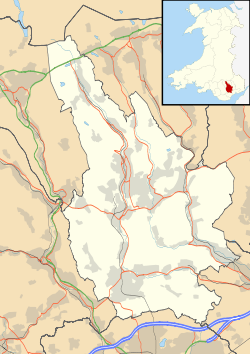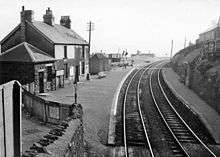Bedwas
| Bedwas | |
 Bedwas |
|
| Population | 8,512 |
|---|---|
| OS grid reference | ST175895 |
| Principal area | Caerphilly |
| Ceremonial county | Gwent |
| Country | Wales |
| Sovereign state | United Kingdom |
| Post town | CAERPHILLY |
| Postcode district | CF83 |
| Dialling code | 029 |
| Police | Gwent |
| Fire | South Wales |
| Ambulance | Welsh |
| EU Parliament | Wales |
| UK Parliament | Caerphilly |
|
|
Coordinates: 51°35′33″N 3°12′22″W / 51.5926°N 3.2061°W
Bedwas is a town two miles north-east of Caerphilly, south Wales, situated in the Caerphilly county borough, within the historic boundaries of Monmouthshire.
Bedwas neighbours Trethomas, Graig-y-Rhacca and Machen, and forms a council ward in conjunction with those communities.
Early history
Traditionally a farming community,[1] Bedwas was originally called Lower Bedwas. Maesycwmmer, a small village not far from Bedwas, was called Upper Bedwas. The two villages became known as what we know them today in the 19th century. Bedwas owes much of its own development to the development of the South Wales coalfield and the Welsh coal mining industry.[2] This is depicted in the early Census records. According to the 1811 census, Lower Bedwas consisted of 47 occupied houses and 65 families. 59 of these families were engaged in agriculture and 6 in trade, manufacture and handicraft. There were 254 residents in Lower Bedwas in 1811, 130 males and 124 females. By 1911, the population had risen to 3231 according to the census. In the late 19th century it was home to four coal pits and the construction of a large-scale colliery, Bedwas Navigation Colliery, had been completed by 1913. The colliery had an explosion in 1912.
Guto Nyth Brân
Bedwas is the town where the 'fastest man in Wales' suffered a fatal injury. After coming out of retirement around the age of 30 a new challenger came forward called Prince. Due to his talent he was called the 'Prince of Bedwas', Guto's wife and manager, Sîan, convinced to race on more time in 1737 for 1000 guineas or £150,000 in 2015-16.
After winning the 12 mile race between Bedwas and Newport, he suffered a heart attack in the arms of his wife after a hard slap on the back. There is a plaque commemorating the tragic runner opposite the Church Inn, on the wall of the Church at the top of the village.
Present
Bedwas Navigation Colliery, along with other collieries, closed in the Miners' Strike of 1984–85, and did not re-open. Light industry replaced mining as the main local employer. Bedwas House Industrial Estate houses the home of the nationwide brand Peter's Pies, a local depot for Stagecoach Buses, DAS Motor Claims Centre, and formerly a warehouse for General Electric.
Transport

Transport of both passengers and coal was provided by a local station located on the Brecon and Merthyr Tydfil Junction Railway. The line was never profitable even after grouping into the Great Western Railway company, and hence all passenger services were withdrawn by British Railways by December 1962 before the Beeching Axe. By 1980 only one section of 10.5 miles (16.9 km) survived, serving coal traffic to Bedwas Navigation Colliery, but after its demise the section between Bedwas and Machen was closed in 1985.
Sport

The Bridge Field is home to Bedwas RFC who are currently in the Welsh Premier league and also has an active comprehensive school side. There is also a longstanding Mini & Junior Football team BTM FC that has served the area since 1969,[3] the club runs girls & boys Mini and Junior teams and currently plays in the TERV (Taff Ely & Rhymney Valley) League. Past players for BTM include former Cardiff City captain and Wales International Jason Perry, Former Nottingham Forest player Christian Edwards and Newport County's David Pipe. The club was also an important part of the Bedwas and Trethomas Community Association which after over 10 years of fighting last year succeeded in getting a community hall built on the clubs site at Bryn Field, Bedwas which allows the club access to the excellent facilities the hall offers.
Parish church

The parish church is dedicated to St. Barrwg, who was a disciple of St. Cadoc, and had a hermitage on what is now Barry (Barrwg) Island. The church is affiliated to the Church in Wales. It has a saddle-back tower, and dates back at least to the 12th Century, first appearing in historical records in 1102. The current (2009) rector is the Rev. Peter Crocker.
Health research
Men from Bedwas participate in one of the world's longest running epidemiology studies – The Caerphilly Heart Disease Study. Since 1979, a representative sample of adult males born between 1918 and 1938, living in Caerphilly and the surrounding villages of Abertridwr, Bedwas, Machen, Senghenydd and Trethomas, have participated in the study. A wide range of health and lifestyle data have been collected throughout the study and have been the basis of over 400 publications in the medical press. A notable report was on the reductions in vascular disease, diabetes, cognitive impairment and dementia attributable to a healthy lifestyle.[4]
Popular culture
George Borrow passed through Bedwas in November 1854. He recorded it in his later book of his travels 'Wild Wales' as Pentref Bettws which he said meant village of the bead-house.
References
- ↑ johngriffiths. "St Barrwg's Church Bedwas (C) johngriffiths :: Geograph Britain and Ireland".
- ↑ Roger Cornfoot. "Workmen's Institute, Newport Road,... (C) Roger Cornfoot :: Geograph Britain and Ireland".
- ↑ "Homepage - BTM United".
- ↑ "Caerphilly and Speedwell collaborative heart disease studies. The Caerphilly and Speedwell Collaborative Group". Journal of Epidemiology and Community Health. 38 (3): 259–262. 1984. doi:10.1136/jech.38.3.259. PMC 1052363
 . PMID 6332166..
. PMID 6332166..

